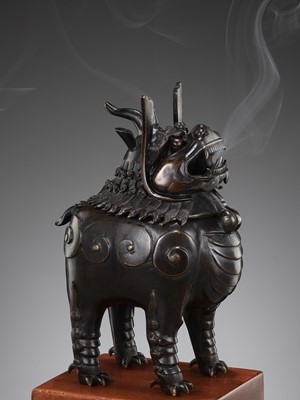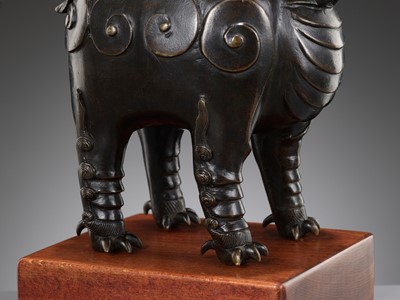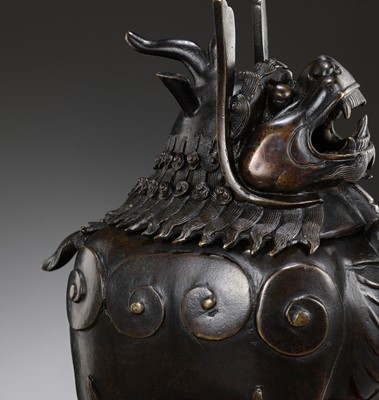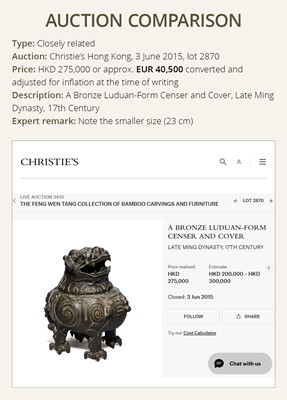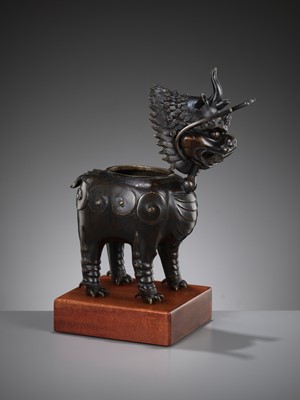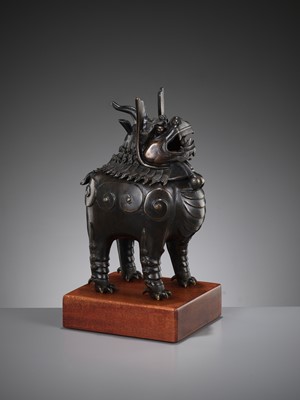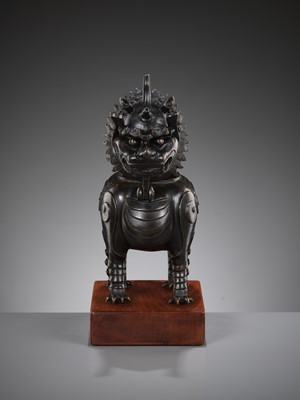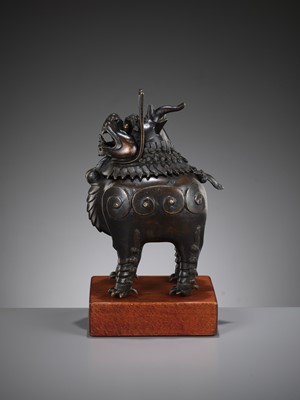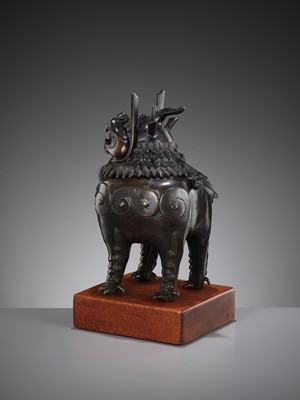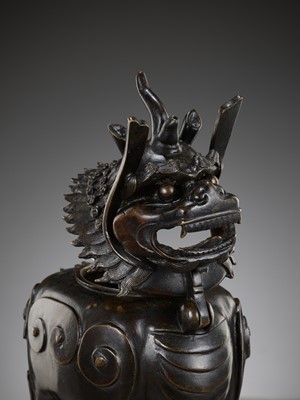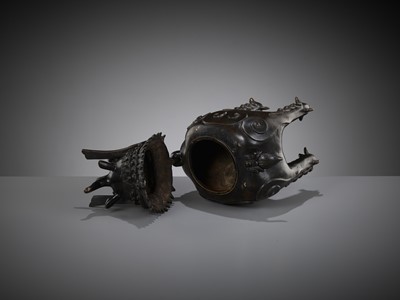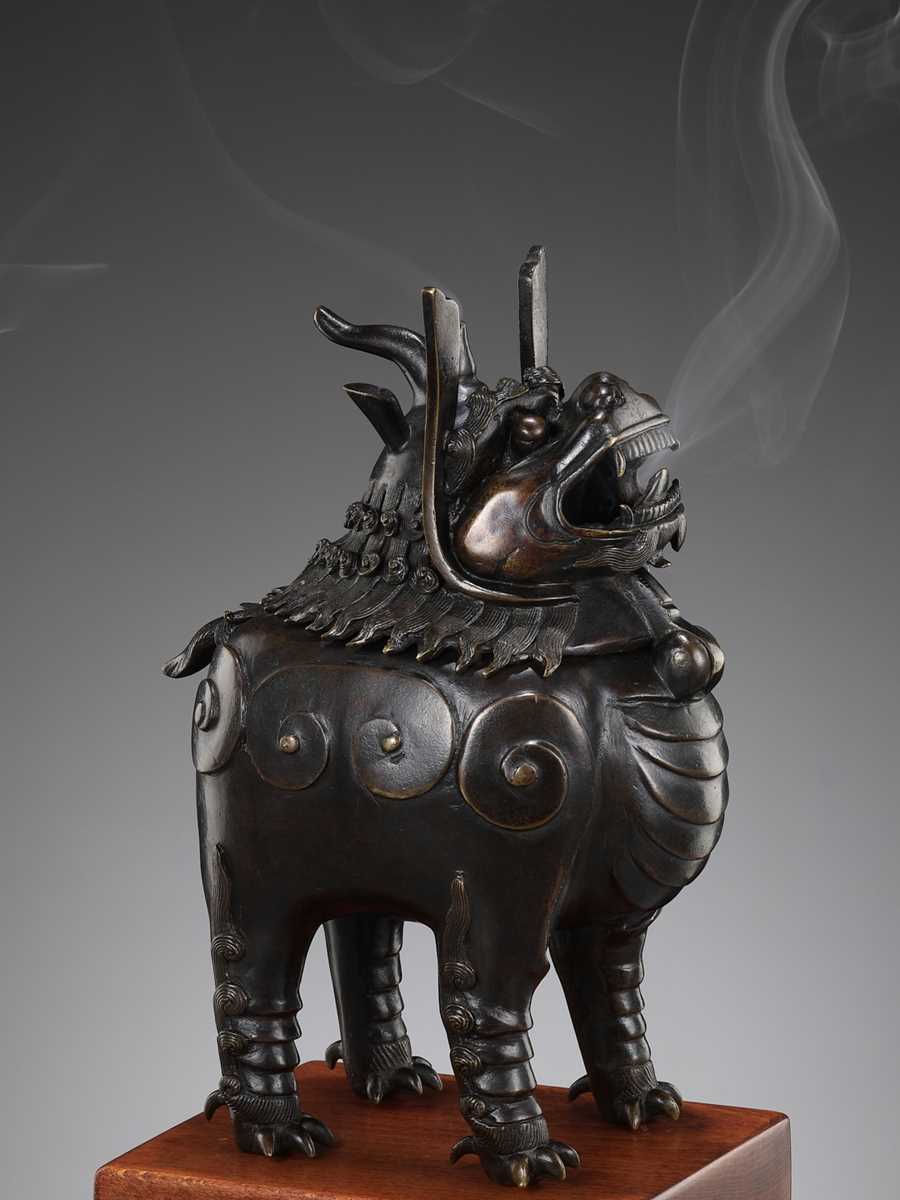9th Mar, 2023 13:00
TWO-DAY AUCTION - Fine Chinese Art / 中國藝術集珍 / Buddhism & Hinduism
148
A LUDUAN-FORM BRONZE CENSER, MING DYNASTY
明代甪端銅香薰
Sold for €11,700
including Buyer's Premium
China, 1368-1644. Finely cast standing foursquare, the chest of the hollow body with a long strip of scaling, the sides with swirls and stylized ruyi-heads, flanking a short tail. The hinged cover rendered in the form of a single-horned head with bulging eyes, scrolling mane, and funnel-shaped ears, the mouth wide open revealing tongue and teeth.
Provenance: Galerie Gross, Wiesbaden, Germany, 12 December 1980. An old German private collection, according to the family acquired from the above, and thence by descent.
Condition: Very good condition with expected old wear and casting irregularities. The hinge original and remarkably well-preserved, thus functioning properly. A few minuscule nicks and small dents. Naturally grown, rich and very dark patina overall.
Weight: 4,612 g
Dimensions: Height 30 cm (excl. base, incl. pegs) and 33.5 cm (incl. base)
With an old wood base. (2)
The throne of the Emperor of China in the Hall of Supreme Harmony in the Forbidden City in Beijing has two incense burners shaped as luduan, the legendary auspicious creatures who can travel 18,000 li (9,000 km) in a single day and speak all world languages. A legend says that a luduan once appeared to Genghis Khan and convinced him to abandon his efforts to conquer India.
Luduan are mythical creatures with strong lion bodies, a single horn and the paws of a bear. They are believed to have the ability to foretell the future, give life to the good, and kill the evil. According to legend, they were originally known as ‘jiaoduan’, and their name changed to ‘luduan’ because the character for ‘lu’ matched their appearance better. Known as guardians of enlightened rulers, luduan were said to appear in areas where a wise and virtuous leader was present.
The auspicious nature of luduan was particularly appropriate for the purpose of these censers. Cast with hinged or removable heads, they were made for burning incense and smoke would emerge from the beast’s mouth, animating and empowering the sculpture. As Chuimei Ho and Bennet Bronson note in their discussion of a pair of Qianlong cloisonné enamel examples from the Palace Museum, Beijing, included in the exhibition ‘Splendors of China's Forbidden City, The Glorious Reign of Emperor Qianlong’ by The Field Museum, Chicago, 2004, these burners were traditionally valued at the Imperial Court, as with their open mouths and smoke billowing forth, they were a reminder to the emperor that he should always be receptive to honest advice (see page 37).
The origin of incense burners of this form is difficult to determine. An example attributed to the Song dynasty was recovered from the Ming dynasty tomb of the scholar-official Zhang Shupei (1552-1615) in Tonglian, Sichuan (Wenwu, 1989, no. 7, pp 45-46, figs 14-16). Mythical beast incense burners, however, became a popular model only from the Xuande period onwards. A censer in the form of a mythological animal was included in the painting ‘Enjoying Antiquities’ by Du Jin (ca. 1467-1505), where two scholars are depicted scrutinizing a selection of antiquities (illustrated in Through the Prism of the Past, Antiquarian Trends in Chinese Art of the 16th to 18th Century, National Palace Museum, Taipei, 2003, catalog no. I-44). A drawing of a similar beast is also published in the Shizu zhai jian pu (Ten Bamboo Studio Catalogue of Letter Paper Designs), a woodblock printed book of stationery papers from 1645, compiled by Hu Zhengyan and illustrated in Ip Yee and Laurence C.S. Tam, Chinese Bamboo Carving, volume 1, Hong Kong, 1978, page 179, figure 15. Its popularity continued well into the Kangxi reign, when censers of this form were made in a variety of media, including porcelain, cloisonné enamel, and bronze.
Auction result comparison:
Type: Closely related
Auction: Christie’s Hong Kong, 4 April 2017, lot 60
Price: HKD 350,000 or approx. EUR 49,500 converted and adjusted for inflation at the time of writing
Description: A Rare Bronze Luduan-Form Censer, Yuan-Ming Dynasty (1279-1644)
Expert remark: Note the similar size (35.2 cm)
Auction result comparison:
Type: Closely related
Auction: Christie’s Hong Kong, 3 June 2015, lot 2870
Price: HKD 275,000 or approx. EUR 40,500 converted and adjusted for inflation at the time of writing
Description: A Bronze Luduan-Form Censer and Cover, Late Ming Dynasty, 17th Century
Expert remark: Note the smaller size (23 cm)
明代甪端銅香薰
中國,1368-1644年。銅香薰,作獨角甪端形象,昂首傲立,蹲伏狀。雙目圓瞪,發須如火焰紋,前胸配以纓絡鈴鐺,身體兩側有如意狀紋飾,頭部與身體相分開。腹部中空,設計巧妙。體態飽滿圓潤。
來源:德國威斯巴登Galerie Gross藝廊,1980年12月12日;一個德國私人收藏,在同一家族保存至今。
品相:狀況極好,有磨損和鑄造不規則現象。原始鉸鏈且保存完好,因此可以正常使用。一些微小的刻痕和小凹痕。自然包漿細膩。
重量:4,612 克
尺寸:高 30 厘米 (不含底座,含釘子),33.5 厘米 (不含底座)
木底座。(2)
故宮太和殿兩邊就有一對甪端陳設。以甪端護衛在側,顯示皇帝為有道明君。甪端是一種傳說中的神獸,據說日行一萬八千方裡,通四方語言。傳說曾經有甪端出現在成吉思汗面前,說服他放棄征服印度。
甪端與麒麟相似,其形怪異,犀角、獅身、龍背、熊爪、魚鱗、牛尾。相傳,他們原名‘角端’,後來因‘祿’字與他們的相貌相配而改名為‘祿端’。 《宋書·符瑞志下》記載:“甪端日行萬八千里,又曉四夷之語,聖主在位,明達方外幽遠,則奉書而至。”
故甪端形像在明清兩代宮廷多有製作,且多以之為香熏,頭部使用鉸鍊或可移動,在故宮藏品中皆有可見。香可以從神獸的嘴中出,靈獸如生,吐納煙霧。何翠楣及 Bennet Bronson 論及北京故宮博物院收藏一對掐絲琺瑯例,曾展於《Splendors of China's Forbidden City. The Glorious Reign of Emperor Qianlong》,菲爾特自然史博物館,芝加哥,2004年。二人並述,此類爐深受帝皇青睞,因其敞開獸口,煙霧湧溢,警惕君主廣納諫言(見第 37 頁)。
這種形式的香薰溯源很難確定。出土自四川銅梁明代文官張叔佩墓(1552-1615年),參考《文物》,1989年,號7,頁45-46,圖14-16。靈獸形熏爐直到宣德年間才流行。杜堇(約1467-1505年)《玩古圖》刻畫兩位文人鑒賞鼎彝古物,其中包括一件瑞獸熏爐,圖見《古色——十六至十八世紀藝術的仿古風》,臺北,2003年,編號 I-44。首印於1645年的胡正言編印《十竹齋箋譜》,其中木刻版畫插圖描繪一頭類似瑞獸,載於葉義及譚志成,《中國竹刻藝術》,上冊,香港,1978年,第179頁,圖15。此類靈獸之熏爐自宣德朝一直流行至康熙年間,而康熙朝更製作類同形制之瓷器、掐絲琺瑯及銅熏爐,材質多樣。
拍賣結果比較:
形制:非常相近
拍賣:香港佳士得,2017年4月4日,lot 60
價格:HKD 350,000(相當於今日EUR 49,500)
描述:元/明銅甪端形香薰
專家評論:請注意相似的尺寸(35.2 厘米) 。
拍賣結果比較:
形制:非常相近
拍賣:香港佳士得,2015年6月3日,lot 2870
價格:HKD 275,000(相當於今日EUR 40,500)
描述:晚明銅甪端式薰爐
專家評論:請注意尺寸較小(23 厘米)。
China, 1368-1644. Finely cast standing foursquare, the chest of the hollow body with a long strip of scaling, the sides with swirls and stylized ruyi-heads, flanking a short tail. The hinged cover rendered in the form of a single-horned head with bulging eyes, scrolling mane, and funnel-shaped ears, the mouth wide open revealing tongue and teeth.
Provenance: Galerie Gross, Wiesbaden, Germany, 12 December 1980. An old German private collection, according to the family acquired from the above, and thence by descent.
Condition: Very good condition with expected old wear and casting irregularities. The hinge original and remarkably well-preserved, thus functioning properly. A few minuscule nicks and small dents. Naturally grown, rich and very dark patina overall.
Weight: 4,612 g
Dimensions: Height 30 cm (excl. base, incl. pegs) and 33.5 cm (incl. base)
With an old wood base. (2)
The throne of the Emperor of China in the Hall of Supreme Harmony in the Forbidden City in Beijing has two incense burners shaped as luduan, the legendary auspicious creatures who can travel 18,000 li (9,000 km) in a single day and speak all world languages. A legend says that a luduan once appeared to Genghis Khan and convinced him to abandon his efforts to conquer India.
Luduan are mythical creatures with strong lion bodies, a single horn and the paws of a bear. They are believed to have the ability to foretell the future, give life to the good, and kill the evil. According to legend, they were originally known as ‘jiaoduan’, and their name changed to ‘luduan’ because the character for ‘lu’ matched their appearance better. Known as guardians of enlightened rulers, luduan were said to appear in areas where a wise and virtuous leader was present.
The auspicious nature of luduan was particularly appropriate for the purpose of these censers. Cast with hinged or removable heads, they were made for burning incense and smoke would emerge from the beast’s mouth, animating and empowering the sculpture. As Chuimei Ho and Bennet Bronson note in their discussion of a pair of Qianlong cloisonné enamel examples from the Palace Museum, Beijing, included in the exhibition ‘Splendors of China's Forbidden City, The Glorious Reign of Emperor Qianlong’ by The Field Museum, Chicago, 2004, these burners were traditionally valued at the Imperial Court, as with their open mouths and smoke billowing forth, they were a reminder to the emperor that he should always be receptive to honest advice (see page 37).
The origin of incense burners of this form is difficult to determine. An example attributed to the Song dynasty was recovered from the Ming dynasty tomb of the scholar-official Zhang Shupei (1552-1615) in Tonglian, Sichuan (Wenwu, 1989, no. 7, pp 45-46, figs 14-16). Mythical beast incense burners, however, became a popular model only from the Xuande period onwards. A censer in the form of a mythological animal was included in the painting ‘Enjoying Antiquities’ by Du Jin (ca. 1467-1505), where two scholars are depicted scrutinizing a selection of antiquities (illustrated in Through the Prism of the Past, Antiquarian Trends in Chinese Art of the 16th to 18th Century, National Palace Museum, Taipei, 2003, catalog no. I-44). A drawing of a similar beast is also published in the Shizu zhai jian pu (Ten Bamboo Studio Catalogue of Letter Paper Designs), a woodblock printed book of stationery papers from 1645, compiled by Hu Zhengyan and illustrated in Ip Yee and Laurence C.S. Tam, Chinese Bamboo Carving, volume 1, Hong Kong, 1978, page 179, figure 15. Its popularity continued well into the Kangxi reign, when censers of this form were made in a variety of media, including porcelain, cloisonné enamel, and bronze.
Auction result comparison:
Type: Closely related
Auction: Christie’s Hong Kong, 4 April 2017, lot 60
Price: HKD 350,000 or approx. EUR 49,500 converted and adjusted for inflation at the time of writing
Description: A Rare Bronze Luduan-Form Censer, Yuan-Ming Dynasty (1279-1644)
Expert remark: Note the similar size (35.2 cm)
Auction result comparison:
Type: Closely related
Auction: Christie’s Hong Kong, 3 June 2015, lot 2870
Price: HKD 275,000 or approx. EUR 40,500 converted and adjusted for inflation at the time of writing
Description: A Bronze Luduan-Form Censer and Cover, Late Ming Dynasty, 17th Century
Expert remark: Note the smaller size (23 cm)
明代甪端銅香薰
中國,1368-1644年。銅香薰,作獨角甪端形象,昂首傲立,蹲伏狀。雙目圓瞪,發須如火焰紋,前胸配以纓絡鈴鐺,身體兩側有如意狀紋飾,頭部與身體相分開。腹部中空,設計巧妙。體態飽滿圓潤。
來源:德國威斯巴登Galerie Gross藝廊,1980年12月12日;一個德國私人收藏,在同一家族保存至今。
品相:狀況極好,有磨損和鑄造不規則現象。原始鉸鏈且保存完好,因此可以正常使用。一些微小的刻痕和小凹痕。自然包漿細膩。
重量:4,612 克
尺寸:高 30 厘米 (不含底座,含釘子),33.5 厘米 (不含底座)
木底座。(2)
故宮太和殿兩邊就有一對甪端陳設。以甪端護衛在側,顯示皇帝為有道明君。甪端是一種傳說中的神獸,據說日行一萬八千方裡,通四方語言。傳說曾經有甪端出現在成吉思汗面前,說服他放棄征服印度。
甪端與麒麟相似,其形怪異,犀角、獅身、龍背、熊爪、魚鱗、牛尾。相傳,他們原名‘角端’,後來因‘祿’字與他們的相貌相配而改名為‘祿端’。 《宋書·符瑞志下》記載:“甪端日行萬八千里,又曉四夷之語,聖主在位,明達方外幽遠,則奉書而至。”
故甪端形像在明清兩代宮廷多有製作,且多以之為香熏,頭部使用鉸鍊或可移動,在故宮藏品中皆有可見。香可以從神獸的嘴中出,靈獸如生,吐納煙霧。何翠楣及 Bennet Bronson 論及北京故宮博物院收藏一對掐絲琺瑯例,曾展於《Splendors of China's Forbidden City. The Glorious Reign of Emperor Qianlong》,菲爾特自然史博物館,芝加哥,2004年。二人並述,此類爐深受帝皇青睞,因其敞開獸口,煙霧湧溢,警惕君主廣納諫言(見第 37 頁)。
這種形式的香薰溯源很難確定。出土自四川銅梁明代文官張叔佩墓(1552-1615年),參考《文物》,1989年,號7,頁45-46,圖14-16。靈獸形熏爐直到宣德年間才流行。杜堇(約1467-1505年)《玩古圖》刻畫兩位文人鑒賞鼎彝古物,其中包括一件瑞獸熏爐,圖見《古色——十六至十八世紀藝術的仿古風》,臺北,2003年,編號 I-44。首印於1645年的胡正言編印《十竹齋箋譜》,其中木刻版畫插圖描繪一頭類似瑞獸,載於葉義及譚志成,《中國竹刻藝術》,上冊,香港,1978年,第179頁,圖15。此類靈獸之熏爐自宣德朝一直流行至康熙年間,而康熙朝更製作類同形制之瓷器、掐絲琺瑯及銅熏爐,材質多樣。
拍賣結果比較:
形制:非常相近
拍賣:香港佳士得,2017年4月4日,lot 60
價格:HKD 350,000(相當於今日EUR 49,500)
描述:元/明銅甪端形香薰
專家評論:請注意相似的尺寸(35.2 厘米) 。
拍賣結果比較:
形制:非常相近
拍賣:香港佳士得,2015年6月3日,lot 2870
價格:HKD 275,000(相當於今日EUR 40,500)
描述:晚明銅甪端式薰爐
專家評論:請注意尺寸較小(23 厘米)。
Zacke Live Online Bidding
Our online bidding platform makes it easier than ever to bid in our auctions! When you bid through our website, you can take advantage of our premium buyer's terms without incurring any additional online bidding surcharges.
To bid live online, you'll need to create an online account. Once your account is created and your identity is verified, you can register to bid in an auction up to 12 hours before the auction begins.
Intended Spend and Bid Limits
When you register to bid in an online auction, you will need to share your intended maximum spending budget for the auction. We will then review your intended spend and set a bid limit for you. Once you have pre-registered for a live online auction, you can see your intended spend and bid limit by going to 'Account Settings' and clicking on 'Live Bidding Registrations'.
Your bid limit will be the maximum amount you can bid during the auction. Your bid limit is for the hammer price and is not affected by the buyer’s premium and VAT. For example, if you have a bid limit of €1,000 and place two winning bids for €300 and €200, then you will only be able to bid €500 for the rest of the auction. If you try to place a bid that is higher than €500, you will not be able to do so.
Online Absentee and Telephone Bids
You can now leave absentee and telephone bids on our website!
Absentee Bidding
Once you've created an account and your identity is verified, you can leave your absentee bid directly on the lot page. We will contact you when your bids have been confirmed.
Telephone Bidding
Once you've created an account and your identity is verified, you can leave telephone bids online. We will contact you when your bids have been confirmed.
Classic Absentee and Telephone Bidding Form
You can still submit absentee and telephone bids by email or fax if you prefer. Simply fill out the Absentee Bidding/Telephone bidding form and return it to us by email at office@zacke.at or by fax at +43 (1) 532 04 52 20. You can download the PDF from our Upcoming Auctions page.
How-To Guides
How to Create Your Personal Zacke Account
How to Register to Bid on Zacke Live
How to Leave Absentee Bids Online
How to Leave Telephone Bids Online
中文版本的操作指南
创建新账号
注册Zacke Live在线直播竞拍(免平台费)
缺席投标和电话投标
Third-Party Bidding
We partner with best-in-class third-party partners to make it easy for you to bid online in the channel of your choice. Please note that if you bid with one of our third-party online partners, then there will be a live bidding surcharge on top of your final purchase price. You can find all of our fees here. Here's a full list of our third-party partners:
- 51 Bid Live
- EpaiLive
- ArtFoxLive
- Invaluable
- LiveAuctioneers
- the-saleroom
- lot-tissimo
- Drouot
Please note that we place different auctions on different platforms. For example, in general, we only place Chinese art auctions on 51 Bid Live.
Bidding in Person
You must register to bid in person and will be assigned a paddle at the auction. Please contact us at office@zacke.at or +43 (1) 532 04 52 for the latest local health and safety guidelines.
